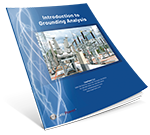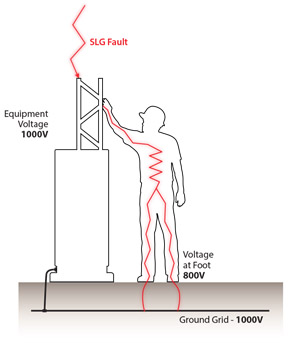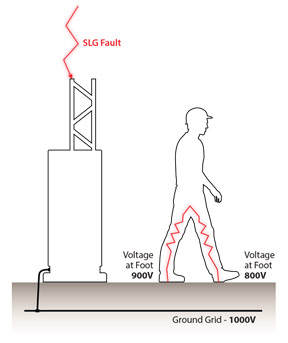Touch and Step Voltage Calculations
When performing a grounding system analysis, it is critical to evaluate the safety of personnel and the public at the power site. During a ground fault condition, the grounding system and surrounding soil voltage is elevated, which is described as the ground (earth) potential rise. Hazardous conditions may arise for individuals as voltage varies from equipment to various points of the soil, characterized as a touch voltage or a step voltage hazard.
Free Intro to Grounding Analysis Book
 Learn more about the concepts in this article and related content in the Introduction to Grounding Analysis Book download for free! This free book serves those in the power industry responsible for analyzing the performance of a grounding (earthing) system, specifically with regard to IEEE Std 80, Guide for Safety in AC Substation Grounding. It is a comprehensive and valuable resource that shows the need for and how to do grounding analysis.
Learn more about the concepts in this article and related content in the Introduction to Grounding Analysis Book download for free! This free book serves those in the power industry responsible for analyzing the performance of a grounding (earthing) system, specifically with regard to IEEE Std 80, Guide for Safety in AC Substation Grounding. It is a comprehensive and valuable resource that shows the need for and how to do grounding analysis.

Touch Voltage
Touch voltage is defined as the potential difference between the ground potential rise of a ground grid or system and the surface potential at the point where a person could be standing while at the same time having a hand in contact with a ground structure.
Touch example: A person has 800 V at his feet, so contact with 1000 V equipment results in a 200 V touch voltage.

Step Voltage
The difference in surface potential that could be experienced by a person bridging a distance of 1 m (3’) with the feet without contacting any grounded object.
Step example: A person is walking with one foot at 900 V and the other at 800 V, resulting in 100 V step voltage.

Evaluating Touch and Step Voltages
In the event of a ground fault it is impossible to eliminate touch or step voltages as the current will take all paths to return to its source. Fortunately, there are a handful of guides and standards in the world that provide methods to evaluate a permissible touch and step voltage. The focus of these documents is to provide calculations to determine a voltage such that an individual is likely to survive the experience, bearing in mind that minimal current though the heart may cause fibrillation. Where analysis indicates permissible voltages are exceeding tolerable magnitudes, there are many approaches to mitigate, such as:
- Expanding or increasing the grounding system to reduce the ground potential rise.
- Installing additional grounding conductor to reduce voltage differences on the soil surface and equipment.
- Adding or expanding a high resistivity surfacing layer material, such as crushed clean gravel or asphalt to reduce current through the individual on the surfacing.
- Accelerating the clearing time of protective settings to reduce the duration of shock.
- Adding physical barriers to limit access to possible hazardous locations.
- Using personal protective equipment to create equipotential zones and/or increase personnel resistance.
Every station is unique, and the correct approach is an engineering design decision to reduce and limit risks.
XGSLab™ Grounding Solution
XGSLab is one of the most powerful software for electromagnetic simulation for power, grounding and lightning protection systems and the only software on the market that takes into account International (IEC/TS 60479-1:2005), European (EN 50522:2010) and American (IEEE Std 80-2000 and IEEE Std 80-2013) Standards in grounding system analysis.